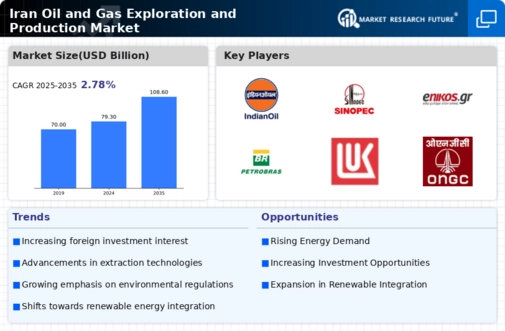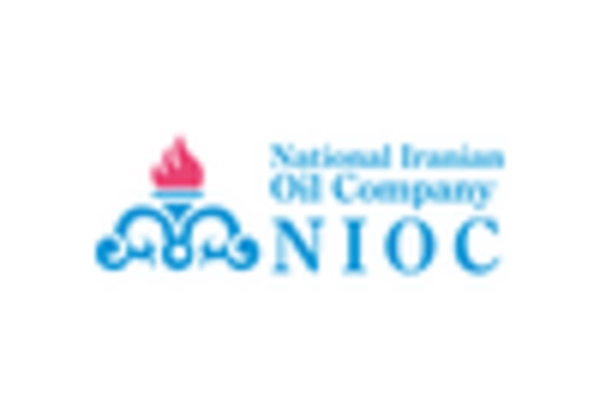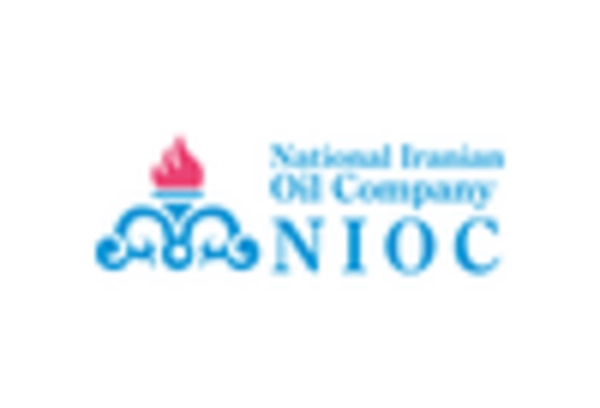Growing Domestic Demand
The rising domestic demand for energy is a significant driver of the Iran Oil and Gas Exploration and Production Market. As the population continues to grow and urbanization accelerates, the need for energy resources is expected to increase substantially. Iran's energy consumption has been on an upward trajectory, with projections indicating a potential increase in natural gas and oil demand in the coming years. This growing demand necessitates a robust exploration and production strategy to ensure energy security and meet the needs of various sectors, including transportation, industry, and residential consumption. The Iranian government is likely to prioritize investments in the oil and gas sector to address this demand, which could lead to enhanced exploration activities and increased production capacity, ultimately shaping the future landscape of the industry.
Technological Innovation
Technological advancements play a crucial role in shaping the Iran Oil and Gas Exploration and Production Market. The adoption of cutting-edge technologies, such as enhanced oil recovery techniques and advanced seismic imaging, can significantly improve the efficiency and effectiveness of exploration and production activities. Iran has been increasingly focusing on integrating modern technologies into its oil and gas operations, which may lead to higher recovery rates and reduced operational costs. The collaboration with international firms specializing in technology transfer could further enhance the capabilities of local companies. As the industry evolves, the emphasis on technological innovation may not only optimize production processes but also contribute to the sustainability of operations, thereby positioning Iran as a competitive player in the energy market.
Rich Hydrocarbon Resources
The abundance of hydrocarbon resources in Iran is a primary driver of the Iran Oil and Gas Exploration and Production Market. With an estimated 158 billion barrels of proven oil reserves and approximately 33 trillion cubic meters of natural gas, Iran's resource base is substantial. This wealth of resources presents significant opportunities for exploration and production activities. The Iranian government has been actively seeking to revitalize its oil and gas sector, aiming to increase production levels and attract foreign investment. Recent initiatives to enhance recovery techniques and improve infrastructure could potentially lead to a more efficient extraction process. As a result, the rich hydrocarbon resources in Iran may stimulate growth and innovation within the industry, fostering a more competitive market environment.
Government Policies and Reforms
The Iranian government has implemented various policies and reforms aimed at revitalizing the oil and gas sector, which serves as a crucial driver for the Iran Oil and Gas Exploration and Production Market. These reforms include the introduction of new contracts designed to attract foreign investment and technology transfer. The government has expressed intentions to increase production capacity significantly, targeting a production level of 5 million barrels per day in the near future. Such ambitious goals indicate a commitment to enhancing the operational landscape for both domestic and international players. Furthermore, the establishment of a more transparent regulatory framework may encourage participation from foreign companies, thereby fostering a more dynamic and competitive market. These government initiatives could potentially reshape the industry, leading to increased exploration and production activities.
Strategic Geopolitical Position
Iran's geographical location is pivotal in the context of the Iran Oil and Gas Exploration and Production Market. Positioned at the crossroads of major energy routes, Iran serves as a critical player in the energy supply chain. The country possesses the world's second-largest natural gas reserves and the fourth-largest proven oil reserves, which enhances its strategic importance. This positioning not only attracts attention from neighboring countries but also from international energy firms seeking to diversify their supply sources. The geopolitical dynamics in the region, including relationships with key players, can influence investment flows and operational strategies within the industry. As such, Iran's strategic location may serve as a catalyst for increased exploration and production activities, potentially leading to enhanced market competitiveness.


















Leave a Comment